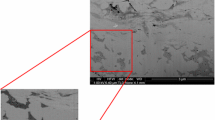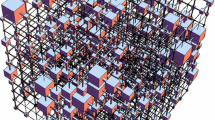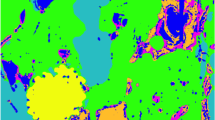Abstract
The macroscopic behavior of gas flow in multi-porosity shale gas reservoirs is rigorously derived within the framework of the reiterated homogenization procedure in conjunction with the Thermodynamics of Inhomogeneous Gases in nanopores. At the nanoscale, the Density Functional Theory is applied to reconstruct general adsorption isotherms and local density profiles of pure methane in the intraparticle porosity of the gas-wet organic matter. The description of adsorption incorporates both repulsive hard sphere effects and Lennard–Jones attractive intermolecular interactions between fluid-fluid supplemented by a fluid-solid exterior potential. Such local description reproduces the monolayer surface adsorption ruled by the Langmuir isotherm in the asymptotic regime of large pore size distributions. The nanoscopic model is upscaled to the microscale where kerogen particles and nanopores are viewed as overlaying continua forming the organic aggregates with adsorbed gas at local thermodynamic equilibrium with the free gas in the water partially saturated interparticle pores. The reaction/diffusion equation for pure gas movement in the kerogen aggregates is coupled with the Fickian diffusion of dissolved gas in the water phase and free gas Darcy flow in the adjacent interparticle pores which also lye in the vicinity of the inorganic solid phase (clay, quartz, calcite) assumed impermeable. By postulating continuity of fugacity between free and dissolved gas in the interparticle pores and neglecting the water movement, we upscale the microscopic problem to the mesoscale, where organic and inorganic matters along with interparticle pores are viewed as overlaying continua. The upscaling gives rise to a new nonlinear pressure equation for gas hydrodynamics in the interparticle pores including a new storativity coefficient dependent on water saturation, total organic carbon content (TOC), and intra- and interparticle porosities. When coupled with the nonlinear single phase gas flow in the hydraulic fractures, the homogenization of the mesoscopic model leads to a new microstructural model of triple porosity type with distributed mass transfer function between the different levels of porosity. Computational simulations illustrate the potential of the multiscale approach proposed herein in providing accurate numerical simulations of methane flow in shale gas reservoirs.
Similar content being viewed by others
References
Akkutlu, I.Y., Fathi, E.: Multiscale gas transport in shales with local kerogen heterogeneities. Soc. Pet. Eng. 17(04), 1002–1011 (2012)
Arbogast, T., Douglas, J., Hornung, U.: Modeling of naturally fractured reservoirs by formal homogenization techniques. In: Dautray, R (ed.) Frontiers in Pure and Applied Mathematics, pp 1–19. Elsevier, Amsterdam (1991)
Auriault, J.L.: Heterogeneous media: Is an equivalent homogeneous description always possible? Int. J. Eng. Sci. 29, 785–795 (1991)
Auriault, J.L., Boutin, C., Geindreau, C.: Homogenization of coupled phenomena in heterogenous media. Wiley (2009)
Barenblatt, G.I., Zhelton, I.P., Kochina, I.N.: Basic concepts in the theory of seepage of homogeneous liquids in fissured rocks. J. Appl. Math. Mech. 24, 1286–1303 (1960)
Bhatia, S.K., Nguyen, T.X., Tran, K., Nicholson, D.: The structure of high-pressure adsorbed fluids in slit-pores. Stud. Surf. Sci. Catal. 160, 503–509 (2007)
Brooks, R.H., Corey, A.T.: Hydraulic properties of porous media, vol. 3. Hydrological Papers (Colorado State University) (1964)
Collin, M., Rasmuson, A.: A comparison of gas diffusivity models for unsaturated porous media. Soil Sci. Soc. Am. J. 52, 1559–1565 (1988)
Daniel, J., Bohm, B., Layne, M.: Hydraulic fracturing considerations for natural gas wells of the marcellus shale. In: The Groundwater Protection Council 2008 Annual Forum, vol. 21-24, Cincinnati, OH (2008)
Darabi, H., Ettehad, A., Javadpour, F., Sepehrnoori, K.: Gas flow in ultra-tight shale strata. J. Fluid Mech. 710, 641–658 (2012)
Douglas, J., Arbogast, T.: Dual porosity models for flow in naturally fractured reservoirs. In: Cushman, J. H (ed.) Dynamics of Fluid in Hierarchical Porous Media, pp 177–222. Academic, New York (1990)
Gonzalez, A., White, J.A., Roman, F.L., Velasco, S.: Density functional theory of fluids in nanopores: analysis of the fundamental measures theory in extreme dimensional-crossover situations. J. Chem. Phys. 125, 64703 (2006)
Javadpour, F.: Nanopores and apparent permeability of gas flow in mudrocks (shales and siltstone). J. Can. Petrol. Technol. 48(8), 16–21 (2009)
Kierlik, E., Rosinberg, M.L.: Density-functional theory for inhomogeneous fluids: adsorption of binary mixtures. Phys. Rev. A 44, 5025–5037 (1991)
Knudsen, M.: The laws of molecular and viscous flow of gases through tubes. Ann. Phys. 28, 75–177 (1909)
Langmuir, I.: The adsorption of gases on plane surfaces of glass, mica and platinum. J. Am. Chem. Soc. 40, 1403–1461 (1918)
Mason, E.A., Malinauskas, A.P.: Gas transport in porous media: the dusty-gas model. Elsevier Science (1983)
Mehmani, A., Prodanovic, M., Javadpour, F.: Multiscale, multiphysics network modeling of shale matrix gas flows. Trans. Porous Media 99, 377–390 (2013)
Nguyen, T.X., Suresh, K.B., Nicholson, D.: Prediction of high-pressure adsorption equilibrium of supercritical gases using density functional theory. Langmuir 2005 21, 3187–3197 (2005)
Prausnitz, J.M., Lichtenthaler, R.N., Azevedo, D., Edmundo, G.: Molecular thermodynamics of fluid-phase equilibria. Prentice Hall (1998)
Ranjbar, E., Hassanzadeh, H.: Matrix-fracture transfer shape factor for modeling flow of a compressible fluid in dual-porosity media. Adv. Water Resour. 34, 627–639 (2011)
Robert, G.L., Robert, M.R., Stephen, C.R., Daniel, M.J.: Morphology, genesis, and distribution of nanometer-scale pores in siliceous mudstones of the mississippian barnett shale. J. Sed. Res. 79, 848–861 (2009)
Rosenfeld, Y.: Free-energy model for the inhomogeneous hard-sphere fluid mixture and density functional theory of freezing. Phys. Rev. Lett. 63(09), 980–983 (1989)
Roth, R.: Fundamental measure theory for hard-sphere mixtures: a review. J. Phys.: Condens. Matter 22, 063102 (2010)
Sakhaee-Pour, A., Bryant, S.: Gas permeability of shale. Soc. Pet. Eng. 15(04), 401–409 (2012)
Segura, C.J., Vakarin, E.V., Chapman, W.G., Holovko, M.F.: A comparison of density functional and integral equation theories vs Monte Carlo simulations for hard sphere associating fluids near a hard wall. J. Chem. Phys. 108, 4837 (1998)
Sondergeld, C.H., Newsham, K.E., Rice, M.C., Rai, C.S.: Petrophysical considerations in evaluating and producing shale gas resources. Society of Petroleum Engineers, SPE Unconventional Gas Conference, Pennsylvania, USA (2010)
Steele, W.A.: The physical interaction of gases with crystalline solids: I. Gas-solid energies and properties of isolated adsorbed atoms. Surf. Sci. 36(01), 317–352 (1973)
Warren, J.E., Root, P.J: The behavior of naturally fractured reservoirs. Soc. Pet. Eng. 3, 245–255 (1963)
Yu, W., Sepehrnoori, K.: Simulation of gas desorption and geomechanics effects for unconventional gas reservoirs. Fuel 116, 455–464 (2014)
Witherspoon, P.A., Saraf, D.N.: Diffusion of methane, ethane, propane, and n-butane in water from 25 to 43 °. J. Phys. Chem. 69(11), 3752–3755 (1965)
Yan, B., Wang, Y., Killough, J.E.: Beyond dual-porosity modeling for the simulation of complex flow mechanisms in shale reservoirs. Society of Petroleum Engineers, SPE Reservoir Simulation Symposium (2013)
Ziarani, A., Aguilera, R.: Knudsen’s permeability correction for tight porous media. Trans. Porous Media 91, 239–260 (2012)
Author information
Authors and Affiliations
Corresponding author
Rights and permissions
About this article
Cite this article
Le, T.D., Murad, M.A., Pereira, P.A. et al. Bridging between macroscopic behavior of shale gas reservoirs and confined fluids in nanopores. Comput Geosci 20, 751–771 (2016). https://doi.org/10.1007/s10596-015-9511-x
Received:
Accepted:
Published:
Issue Date:
DOI: https://doi.org/10.1007/s10596-015-9511-x




